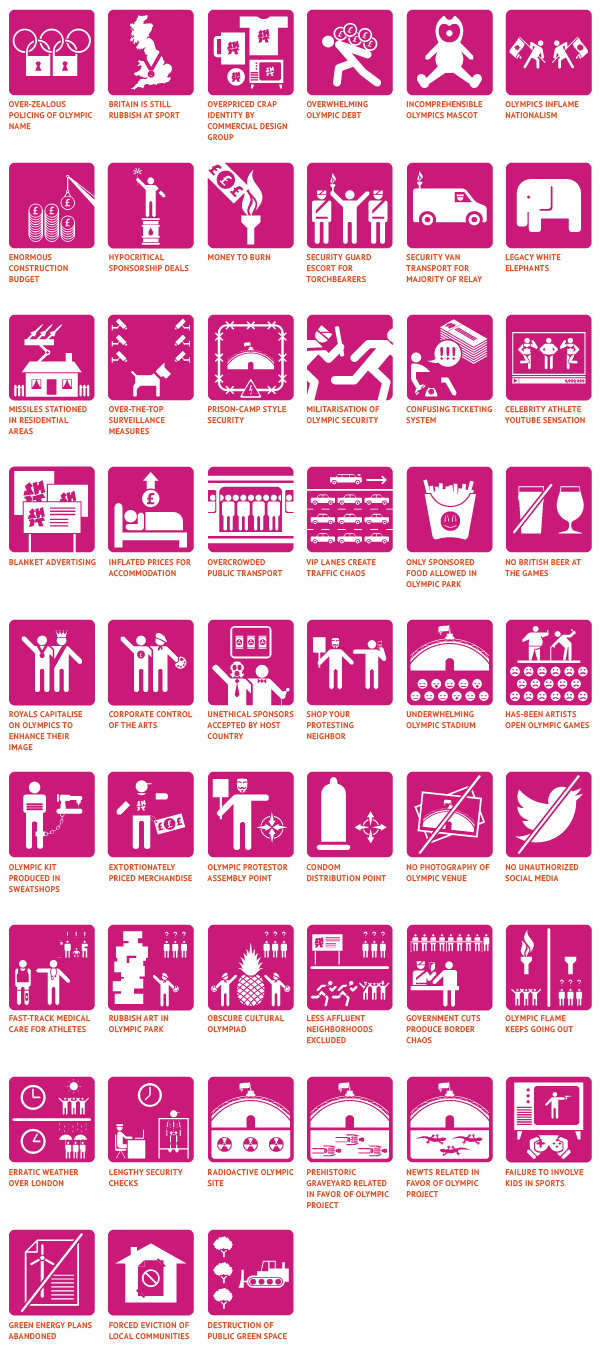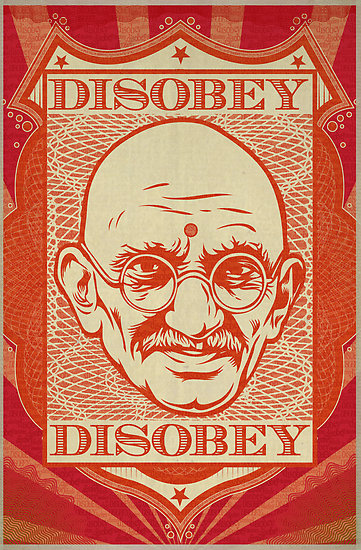Found 4305 matches from 1,400 records in about 0.2409 seconds for phone or e or geodeta.
Olympic pictograms have been used since the 1936 Berlin games to create a visual system of signs for navigating (and decorating) the games and host cities across language barriers. See this writeup or animated appraisal for a visual tour of pictograms through the years.
This year’s London games use two sets of pictograms: simple silhouettes for utilitarian communication and a more exuberant version for decorative applications.
In 2004 VirusFonts reinterpreted the Olympic pictogram in a series of satirical icons to puncture the heroism and reflect the bribery, political manipulation, drugs and greed behind the Athens Olympics. Last week they released a new set to reflect on the controversies and accusations leveled at the 2012 London games. The pictograms riff on the iconic style developed by Otl Aicher for the 1972 Munich Olympics.
Below, the full set of 2012 Olympukes:
Olympukes 2012 is available for download as a font and is free for personal, non-commercial use.
I enjoyed this simple détournement by LibertyManiacs of Shepard Fairey’s platitudinous brand. Irony vs irony = sincerity?
 Researchers at Harvard scraped Chinese social media sites to produce this fascinating analysis of censorship patterns: criticism of the Government and its leaders are actually OK, but grievances that spread virally or suggestions of collective action are removed within 24 hours.
Researchers at Harvard scraped Chinese social media sites to produce this fascinating analysis of censorship patterns: criticism of the Government and its leaders are actually OK, but grievances that spread virally or suggestions of collective action are removed within 24 hours.
The abstract follows (my emphasis added):
“We offer the first large scale, multiple source analysis of the outcome of what may be the most extensive effort to selectively censor human expression ever implemented. To do this, we have devised a system to locate, download, and analyze the content of millions of social media posts originating from nearly 1,400 different social media services all over China before the Chinese government is able to find, evaluate, and censor (i.e., remove from the Internet) the large subset they deem objectionable.
Using modern computer-assisted text analytic methods that we adapt and validate in the Chinese language, we compare the substantive content of posts censored to those not censored over time in each of 95 issue areas. Contrary to previous understandings, posts with negative, even vitriolic, criticism of the state, its leaders, and its policies are not more likely to be censored. Instead, we show that the censorship program is aimed at curtailing collection action by silencing comments that represent, reinforce, or spur social mobilization, regardless of content. Censorship is oriented toward attempting to forestall collective activities that are occurring now or may occur in the future — and, as such, seem to clearly expose government intent, such as examples we offer where sharp increases in censorship presage government action outside the Internet.”
You can download the full paper here.
Always interesting are the clever ways Chinese bloggers route around automated keyword filters using images, puns, and “homographs” — characters with different meanings that have similar shapes. This results in some massive “community management” mechanics: much censorship is largely manual labor on the part of hundreds of thousands of Internet police and “50 cent party members.”
I also find echoes of the Chinese censorship pattern resonate in the U.S. media landscape (including the design literature) though not as explicit censorship, per se. While criticism, dissent and rebellion are celebrated, commodified and institutionalized here (“Maverick for President!”), grievances that have potential to mobilize or stories about political organizing or collective action potential are harder to come by.
Great piece via Mike on design and culture in Jacobin magazine. Some choice cuts:
“Design is one of the linchpins of capitalism, because it makes alienated labor possible.
…
[W]hen it comes to design’s influence on social structures, the focus on consumerism distracts from something more significant and interesting. Design’s real power is that it makes relationships and divisions between people concrete. Without physical stuff to remind us of how we supposedly differ from one another, our hierarchies would be awfully ramshackle; stripped of our possessions, categories like “class” start to look like just a bunch of learned behaviors and confused ideas. Whether prohibitively priced cars, gendered garments, or separate schools for blacks and whites, social hierarchies are always maintained with the help of physical objects and spaces designed to reflect those hierarchies. Otherwise everyone’s claims of superiority and difference would be quite literally immaterial.
…
Once you realize that all designed objects carry this sort of encrypted information about the organization of society, something amazing happens: you suddenly stop feeling bored in home furnishings stores. Washing machines and cooking implements have a lot to say about norms surrounding domestic labor; office trash cans embody the values of a middle class that can’t deal with its own waste; alarm systems and porch lights offer a crash course in the popular phenomenology of crime. But these objects are not just passive representations of ideas about how society should run. They actively promote those ideas, validating certain prejudices and chastising us when our behavior deviates from certain norms.”
Read the rest.
page 1 2 3 4 5 6 7 8 9 10 11 12 13 14 15 16 17 18 19 20 21 22 23 24 25 26 27 28 29 30 31 32 33 34 35 36 37 38 39 40 41 42 43 44 45 46 47 48 49 50 51 52 53 54 55 56 57 58 59 60 61 62 63 64 65 66 67 68 69 70 71 72 73 74 75 76 77 78 79 80 81 82 83 84 85 86 87 88 89 90 91 92 93 94 95 96 97 98 99 100 101 102 103 104 105 106 107 108 109 110 111 112 113 114 115 116 117 118 119 120 121 122 123 124 125 126 127 128 129 130 131 132 133 134 135 136 137 138 139 140 141 142 143 144 145 146 147 148 149 150 151 152 153 154 155 156 157 158 159 160 161 162 163 164 165 166 167 168 169 170 171 172 173 174 175 176 177 178 179 180 181 182 183 184 185 186 187 188 189 190 191 192 193 194 195 196 197 198 199 200 201 202 203 204 205 206 207 208 209 210 211 212 213 214 215 216 217 218 219 220 221 222 223 224 225 226 227 228 229 230 231 232 233 234 235 236 237 238 239 240 241 242 243 244 245 246 247 248 249 250 251 252 253 254 255 256 257 258 259 260 261 262 263 264 265 266 267 268 269 270 271 272 273 274 275 276 277 278 279 280 281 282 283 284 285 286 287 288 289 290 291 292 293 294 295 296 297 298 299 300 301 302 303 304 305 306 307 308 309 310 311 312 313 314 315 316 317 318 319 320 321 322 323 324 325 326 327 328 329 330 331 332 333 334 335 336 337 338 339 340 341 342 343 344 345 346 347 348 349 350 351 352 353 354 355 356 357 358 359 360 361 362 363 364 365 366 367 368 369 370 371 372 373 374 375 376 377 378 379 380 381 382 383 384 385 386 387 388 389 390 391 392 393 394 395 396 397 398 399 400 401 402 403 404 405 406 407 408 409 410 411 412 413 414 415 416 417 418 419 420 421 422 423 424 425 426 427 428 429 430 431
[ Back ]
[ Next ]



